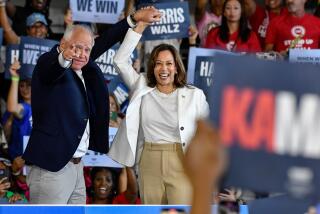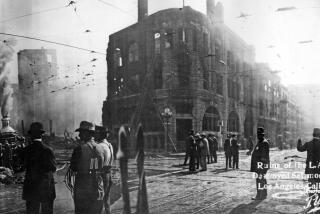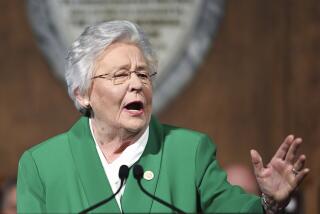The Return of John L. Lewis?
CHARLOTTESVILLE, VA. — Will AFL-CIO President John J. Sweeney become the John L. Lewis of our time, the man who revives the fortunes of America’s once great labor movement? Lewis, the great bear of a orator who led the industrial unions to power in the 1930s, seemed ever present to those who saw the remarkable victory of Sweeney’s insurgent slate at the 1995 AFL-CIO convention.
Since then, Sweeney and his new team have indeed begun to make some Lewis-like moves. They lead demonstrations, make speeches and show up on the picket lines; the AFL-CIO’s Organizing Institute put 1,000 young activists on the street in this year’s “union summer” project, and they have enraged the Republicans by putting much money and energy into political action.
History does not repeat itself, nor does it offer a formula for social change, but the contemporary upheaval inside the AFL-CIO bears a strong resemblance to the dramatic transformation in union leadership that launched the Committee for Industrial Organization more than 60 years ago. If we think about what happened then, perhaps it can guide us today.
Both Lewis and Sweeney moved to unionism’s center stage because a Democratic president failed them. Though the 1935 Wagner Act is now remembered as the keystone of New Deal labor legislation, Lewis, Sidney Hillman and other unionists had staked far more on President Franklin D. Roosevelt’s first effort to make organized labor a part of the Hew Deal: the reorganization of capitalism under the National Recovery Administration. The big corporations were given a free ride to set prices and cartelize production, and in return the government asserted that workers had a right to “unions of their own choosing.”
President Bill Clinton tried to cut much the same social bargain during the first two years of his administration: He’d let a handful to big insurance companies run the health-care system in return for universal coverage; and he expected a commission chaired by John T. Dunlop, former labor secretary, to make union organizing easier, in return for which managers would get a chance to set up employee participation committees that most unionists found distasteful.
Old-guard labor leaders were paralyzed when the reforms of both Roosevelt and Clinton floundered. The Supreme Court declared the NRA unconstitutional in 1935: and 60 years later, Rep. Newt Gingrich (R-Ga.) smashed Clinton’s effort to create universal coverage.
The old American Federation of Labor, fixated by a rigid commitment to “exclusive jurisdiction,” clung to an underfunded, highly fragmented, craft union organizing strategy doomed to fail in America’s mass-production factories. Lewis founded the Committee for Industrial Organization, in 1935, because he saw only disaster unless union progressives broke with this AFL non-program. “They seduced me with fair words,” declared Lewis at the convention where he dramatically knocked down an AFL stalwart “I am enraged and I am ready to rend my seducers limb from limb.”
Similarly, Sweeney and company challenged AFL-CIO President Lane Kirkland because he had no new ideas to cope with the collapse of Clinton’s social program. Kirkland had long argued it was useless to pour money into organizing campaigns until Congress passed a new labor law. But Sweeney’s approach seems to more closely mirror that of the early CIO--which sought to mobilize workers regardless of the judiciary’s interpretation of the law. Thus the CIO scored all its great victories--often using the legally questionable sit-down strike--months before the Supreme Court validated the Wagner Act in April, 1937.
Lewis opened the CIO to the cadres of the left: Trotskyites, Socialists and Communists were put on the payroll and thrown into the large organizing drives. This was not because Lewis was much of a radical: In the United Mine Workers, he had a well-deserved reputation as an autocrat who voted Republican in most elections. But Lewis knew that he needed organizers from the left as much as they needed the opportunities opened up by the new CIO. When reporters probed his decision to hire so many Communists, Lewis replied, “Who gets the bird? The hunter or the dog?” As it turned out, the dog got quite a few birds: The leftists with whom Lewis cooperated were energetic, young and confident they were marching with the tide of history. Union radicals like the UAW’s Walter P. Reuther and longshore leader Harry Bridges soon emerged as labor’s new men of power.
Like Lewis, Sweeney is not much of a radical. He’s a middle-aged Irish Catholic from the Bronx. But he, too, is opening a door to the left, ending the long Cold War that divided union leadership not only from the aging radicals of the ‘60s generation, but from the gay, feminist and green activists that define so much that is lively among the Generation X-ers. One example of this rapprochement came several weeks ago, when Sweeney and other top unionists shared the podium with the academic left at a Columbia University “teach-in with the labor movement.” Breaking with decades of stiff-necked isolation, Sweeney told an overflow audience of students and professors, “We need your help.”
It’s impossible to know if this gamble will pay off. In the 1930s, the labor left was often rooted in America’s Italian, Jewish and German working-class communities, and full of the self-confidence that seemed to grow out of capitalism’s imminent collapse. That tradition is dead. But there is another American insurgency that Sweeney and company seem to be counting on: One lodged deep within the Latino, Asian and African-American communities, or among the white working-class youth whose expectations have been so diminished during the last two decades. If the unions are ever to organize the multicultural workers of America’s low-wage service sector, these are the women and men who will spearhead the fight.
But organizing is not enough. In the 1930s, Lewis understood that the road to a revitalized union movement also required a bold political breakthrough. Lewis was never comfortable as a Democrat, but in 1936 he calculated that Roosevelt’s reelection was essential to the success of labor’s far-flung organizing campaigns. So he ordered UAW radicals to drop their support of a Farmer-Labor Party and endorse Roosevelt if they wanted $100,000 from the CIO treasury to organize at General Motors. Lewis followed through with a huge $500,000 contribution to Roosevelt 1936 campaign. When FDR then condemned the anti-labor “money changers and economic royalists,” he brought millions of workers into the streets and set the stage for the dramatic CIO victories at GM and U.S. Steel early the next year.
Neither Roosevelt nor the Democratic Party ever again played such a role. Roosevelt presided over a party that included city bosses and Southern bourbons, among labor’s most bitter enemies. Thus, when FDR condemned both the unions and management during the bloody “little steel” strikes of 1937, the labor chieftain denounced Roosevelt as one “who had supped at labor’s table,” but then “cursed with equal fervor and fine impartiality both labor and its adversaries when they become locked in deadly embrace.”
Lewis vainly sought a political alternative--either a third party or a transformation of the Democrats into a labor-based party. Failing at both, he soon repudiated Roosevelt, only to endorse Wendell Willkie, the GOP candidate in the 1940 election.
Today, neither Sweeney nor any other trade unionist would dare hope that the Democrats might become the kind of party that spoke forthrightly on behalf of labor. Along with the National Education Assn., the AFL-CIO has had the largest single bloc of delegates at every Democratic Convention of the last 20 years, but you would never know it from reading the platform or listening to the campaign rhetoric. Given the decay into which America’s political party system has fallen, progressives should understand that if Sweeney hopes to become the Lewis of our era, he, too, should put a reassessment of the AFL-CIO’s political options high on his agenda.
More to Read
Inside the business of entertainment
The Wide Shot brings you news, analysis and insights on everything from streaming wars to production — and what it all means for the future.
You may occasionally receive promotional content from the Los Angeles Times.









